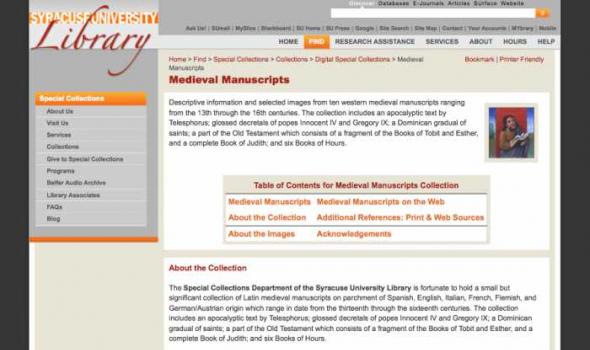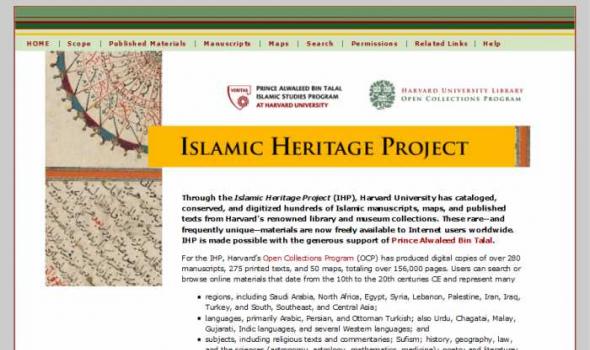Category: Social Sciences, English, Manuscript, United States
Results
Medieval Manuscripts Descriptive information and selected images from ten western medieval manuscripts ranging from the 13th through the 16th centuries. The collection includes an apocalyptic text by Telesphorus; glossed decretals of popes Innocent IV and Gregory IX; a Dominican gradual of saints; a part of the Old Testament which consists of a fragment of the Books of Tobit and Esther, and a complete Book of Judith; and six Books of Hours. About the Collection The Special Collections Department of the Syracuse University Library is fortunate to hold a small but significant collection of Latin medieval manuscripts on parchment of Spanish, English, Italian, French, Flemish, and German/Austrian origin which range in date from the thirteenth through the sixteenth centuries.
The Saganet is a cooperative project by The National and University Library of Iceland and Cornell University with the association of the Árni Magnússon Institute to give access via the Internet to digital images of about 240.000 manuscript pages and 153.000 printed pages. The Saganet was opened on July 1, 2001 but work started on July 1, 1997.
Last updated: 14 January 2009 The Loss and Recovery of Greek Medicine in the West After the fall of the Roman Empire in the 5th century, most works of the Greek physicians were lost to Western Europe. In the 14th and 15th centuries, however, Western Europeans began to rediscover Greek scientific and medical texts. This was due in part to the discovery of Arab repositories of learning in Spain and elsewhere during the Crusades as well as the immigration to Italy of Byzantine scholars at the fall of Constantinople in 1453.
History of Medicine Robert Hooke (1635-1703) was a remarkably versatile man — artist, biologist, physicist, engineer, architect, inventor, and more. However, his crowning glory was Micrographia: or Some Physiological Descriptions of Minute Bodies made by Magnifying Glasses , first published 1665. It was a masterpiece — an exquisitely illustrated introduction to the previously unknown microscopic world. This exhibit focuses on Hooke's influences and legacy in print, the pioneering books that stimulated Hooke's research, and the works he left for others — most famously the great Dutch microscopist, Antoni van Leeuwenhœk (1632-1723). August 1 – November 1, 2007.
About This Collection The Hay Library’s famed collection of manuscripts authored or signed by Lincoln, now comprising nearly 1,100 pieces in all, represents the accumulation of many years of active collecting by private individuals and Friends of the Brown University Library. These materials came to the Library in a number of ways. The original core of the collection included 134 manuscripts by Lincoln and another 183 by close associates of Lincoln. These materials came to the Library in 1923 as part of the Lincoln collection compiled by Charles Woodbury McLellan, one of the five great Lincoln collectors in the early 20th century. Since then, manuscripts have been added both by gift and by purchase. The first major addition to the collection was made by John D.
Interest in the Middle East and the Islamic world is at an all time high, generating a corresponding increase in demand for specialized teaching, learning and transmitting critical knowledge and perspectives on this part of the world. Understanding this region involves learning about the social, political, religious and cultural issues – past and present – that shape the Islamic world of today. Studying Middle Eastern cultures and peoples across all time periods provides a crucial framework for understanding the complex relationship between Islam and the West today.
Polar Bear Expedition Digital Materials Because many of the American troops involved in the intervention were from Michigan, the Bentley Historical Library Michigan Historical Collections has long been interested in documenting this episode. This collection contains digitized versions manuscripts and photographs as well as maps and primary printed source materials relating to the Polar Bear Expedition. The primary guide to the Polar Bear Expedition collections held by the Bentley Historical Library can be found here: Polar Bear Expedition Digital Collections .
Proceedings of the 25th International Congress of Papyrology The 25th International Congress of Papyrology took place at the University of Michigan in Ann Arbor from July 29 to August 4, 2007. This was the second time that the Congress convened in Ann Arbor (following the 12th Congress in 1968) and the third in North America (the 16th Congress in 1980 met in New York). Of the approximately 150 papers delivered during the Congress, 80 fully-referreed articles are included in this publication. This is the first time the Proceedings of the International Congress of Papyrology has been published primarily as an online edition. Individual articles are freely available to search, browse, and download.
A London Provisioner's Chronicle, 1550–1563, by Henry Machyn: Manuscript, Transcription, and Modernization is an electronic scholarly edition created by Richard W. Bailey, Marilyn Miller, and Colette Moore. The Chronicle was one of the treasures of the library of the antiquarian Robert Cotton, and it was stored in the same bookcase with the Beowulf manuscript. Its location was in the book press surmounted by a bust of the Roman emperor Vitellius, and it takes its shelf mark in the British Library from that location: Cotton Vitellius F.v. In the terrible fire that did so much damage to this library in the early eighteenth century, the 162 leaves of the diary were badly damaged and portions of the outside margins and the top of the text were charred or burned away.
An image database of historically significant documents, manuscripts, photographs and related graphic materials from public and private collections in the San Fernando Valley. It provides full, open and equal access to materials demonstrating the socio-economic changes and cultural evolution of the San Fernando Valley from the early 19th century through the end of the 20th century.
American Journeys contains more than 18,000 pages of eyewitness accounts of North American exploration, from the sagas of Vikings in Canada in AD1000 to the diaries of mountain men in the Rockies 800 years later. Read the words of explorers, Indians, missionaries, traders and settlers as they lived through the founding moments of American history. View, search, print, or download more than 150 rare books, original manuscripts, and classic travel narratives from the library and archives of the Wisconsin Historical Society. To get started, simply select an activity on the toolbar above. Funded by the U.S. Institute of Museum & Library Services and by private donors, American Journeys is a collaborative project of the Wisconsin Historical Society and National History Day.
"Philip M. Klutznick: Community Builder, Jewish and Civic Leader, Diplomat" presents documents drawn from the Philip M. Klutznick Papers at the Special Collections Research Center, University of Chicago Library. The Papers comprise 175 linear feet (306 boxes) of correspondence, manuscripts, notes, published materials, photographs, scrapbooks, architectural plans, awards and mementos and audio and video recordings. Together, these document Philip M. Klutznick's multi-faceted life and career as a pioneering community developer, philanthropist, United Nations representative, U.S. Secretary of Commerce and leader of the American and international Jewish community.
Search the Collection Advanced Search in Entire Record Title or Type of Text Common Names of Manuscripts Places of Origin or Association Dates of Origin Languages Names of Individuals or Organizations Materials of Construction Imagery Imagery Keyword Books of the Bible and in Entire Record Title or Type of Text Common Names of Manuscripts Places of Origin or Association Dates of Origin Languages Names of Individuals or Organizations Materials of Construction Imagery Imagery Keyword Books of the Bible and in Entire Record Title or Type of Text Common Names of Manuscripts Places of Origin or Association Dates of Origin Languages Names of Individuals or Organizations Materials of Construction Imagery Imagery Keyw
Reading: Harvard Views of Readers, Readership, and Reading History is an online exploration of the intellectual, cultural, and political history of reading as reflected in the historical holdings of the Harvard Libraries. For Internet users worldwide, Reading provides unparalleled digital access to a significant selection of unique source materials: For researchers, teachers, and students who may not have ready access to extensive historical collections, Reading provides an inspired opportunity to participate more fully in this rapidly expanding research area.
Through the Islamic Heritage Project (IHP), Harvard University has cataloged, conserved, and digitized hundreds of Islamic manuscripts, maps, and published texts from Harvard’s renowned library and museum collections. These rare—and frequently unique—materials are now freely available to Internet users worldwide. IHP is made possible with the generous support of Prince Alwaleed Bin Talal . For the IHP, Harvard’s Open Collections Program (OCP) has produced digital copies of over 280 manuscripts, 275 printed texts, and 50 maps, totaling over 156,000 pages. Users can search or browse online materials that date from the 10th to the 20th centuries CE and represent many
Henry of Bratton (Henricus de Brattona or Bractona) was an English judge of the court known as coram rege (later King's Bench) from 1247-50 and again from 1253-57. After his retirement in 1257, he continued to serve on judicial commissions. He was also a clergyman, having various benefices, the last of which being the chancellorship of Exeter cathedral, where he was buried in 1268.
The Digital Scriptorium is a growing image database of medieval and renaissance manuscripts that unites scattered resources from many institutions into an international tool for teaching and scholarly research. It bridges the gap between a diverse user community and the limited resources of libraries by means of sample imaging and extensive rather than intensive cataloguing.





































